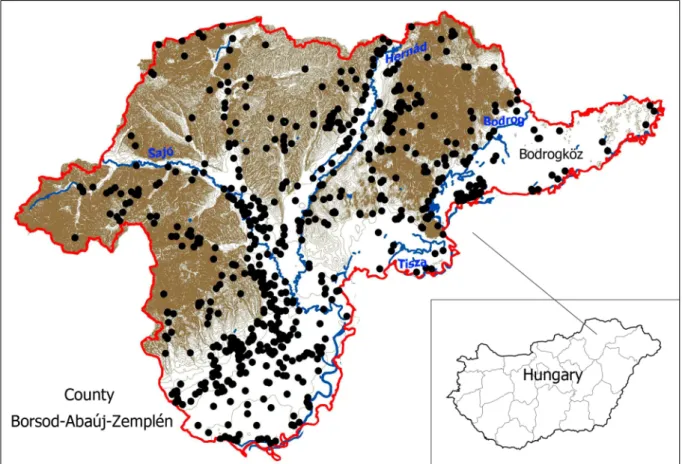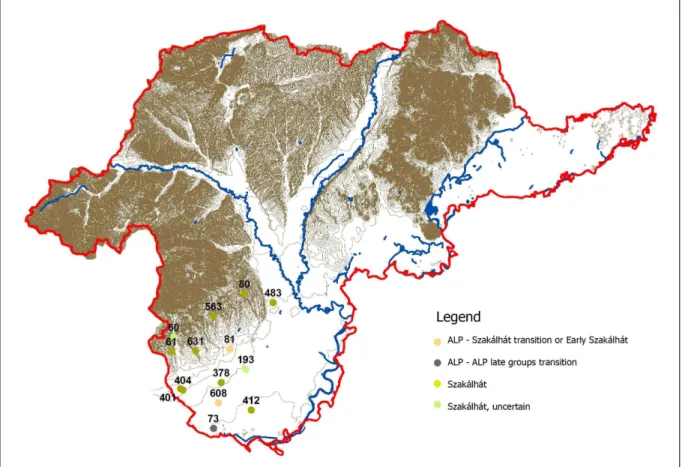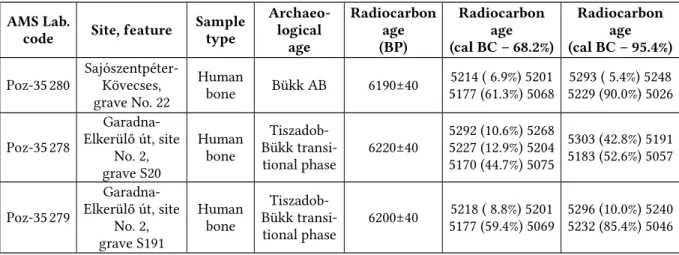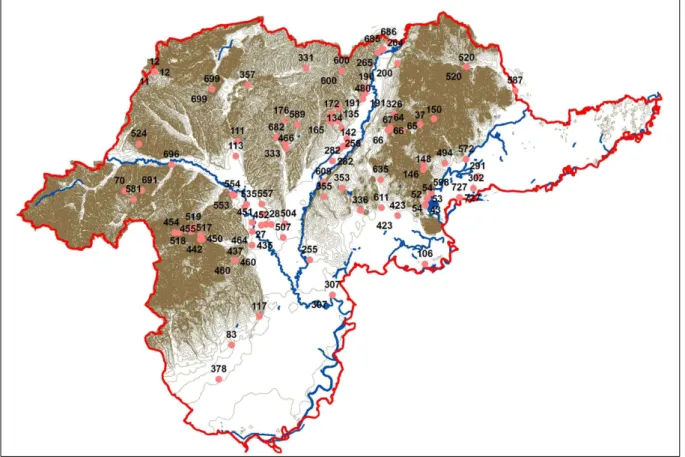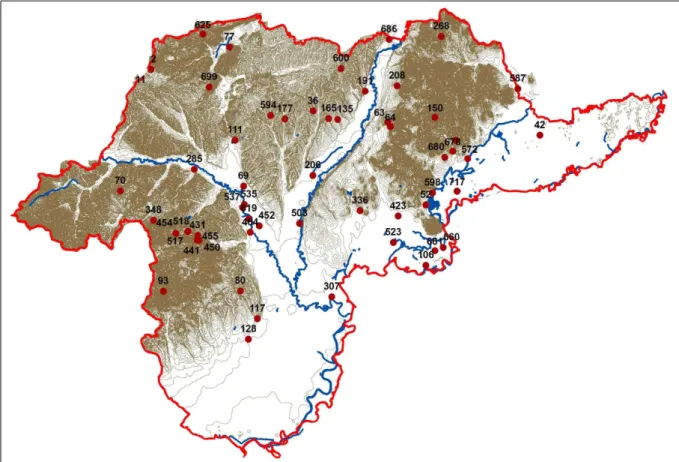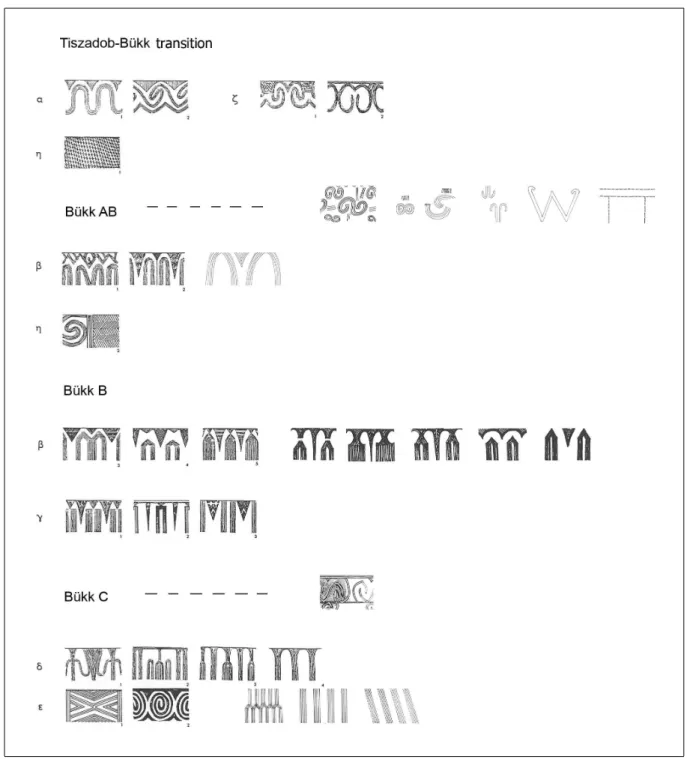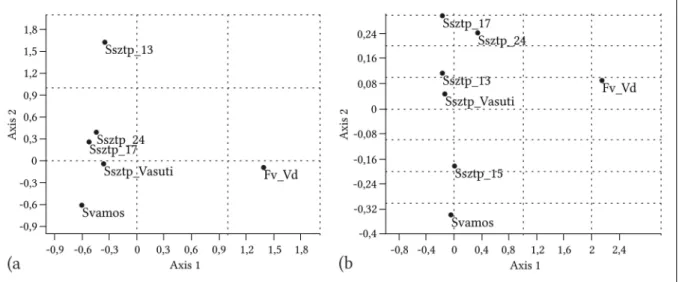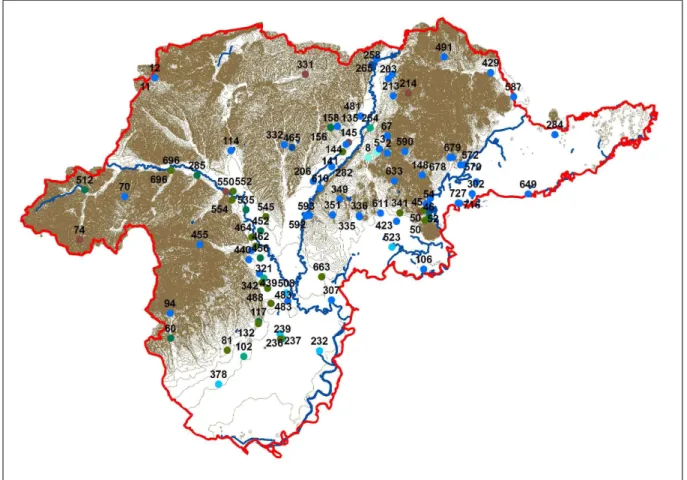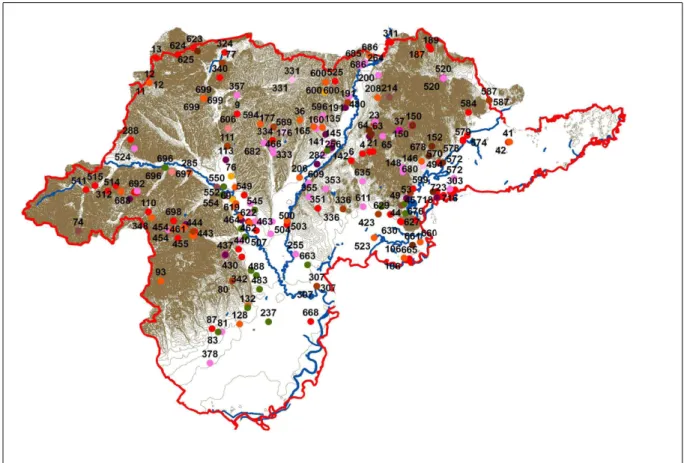Dissertationes Archaeologicae
ex Instituto Archaeologico
Universitatis de Rolando Eötvös nominatae Ser. 3. No. 2.
Budapest 2014
Dissertationes Archaeologicae ex Instituto Archaeologico Universitatis de Rolando Eötvös nominatae
Ser. 3. No. 2.
Editor-in-chief:
Dávid Bartus Editorial board:
László Bartosiewicz László Borhy
István Feld Gábor Kalla
Pál Raczky Miklós Szabó Tivadar Vida Technical editors:
Dávid Bartus Gábor Váczi András Bödőcs
Dániel Szabó Proofreading:
Szilvia Szöllősi
Available online at http://dissarch.elte.hu Contact: dissarch@btk.elte.hu
© Eötvös Loránd University, Institute of Archaeological Sciences Budapest 2014
Contents
Selected papers of the XI . Hungarian Conference on Classical Studies
Ferenc Barna 9
Venus mit Waffen. Die Darstellungen und die Rolle der Göttin in der Münzpropaganda der Zeit der Soldatenkaiser (235–284 n. Chr.)
Dénes Gabler 45
A belső vámok szerepe a rajnai és a dunai provinciák importált kerámiaspektrumában
Lajos Mathédesz 67
Római bélyeges téglák a komáromi Duna Menti Múzeum yűjteményében
Katalin Ottományi 97
Újabb római vicusok Aquincum territoriumán
Eszter Süvegh 143
Hellenistic grotesque terracotta figurines. Problems of iconographical interpretation
András Szabó 157
Some notes on the rings with sacred inscriptions from Pannonia
István Vida 171
The coinage of Flavia Maxima Helena
Articles
Gábor Tarbay 179
Late Bronze Age depot from the foothills of the Pilis Mountains
Csilla Sáró 299
Roman brooches from Paks-Gyapa – Rosti-puszta
András Bödőcs – Gábor Kovács – Krisztián Anderkó 321
The impact of the roman agriculture on the territory of Savaria
Lajos Juhász 333
Two new Roman bronzes with Suebian nodus from Brigetio
Field reports
Zsolt Mester – Norbert Faragó – Attila Király 351
The first in situ Old Stone Age assemblage from the Rába Valley, Northwestern Hungary
Pál Raczky – Alexandra Anders – Norbert Faragó – Gábor Márkus 363 Short report on the 2014 excavations at Polgár-Csőszhalom
Daniel Neumann – Zsuzsanna Siklósi – Roman Scholz – Márton Szilágyi 377 Preliminary Report on the first season of fieldwork in Berettyóújfalu-Szilhalom
Márton Szilágyi – András Füzesi – Attila Virág – Mihály Gasparik 405 A Palaeolithic mammoth bone deposit and a Late Copper Age Baden settlement and enclosure
Preliminary report on the rescue excavation at Szurdokpüspöki – Hosszú-dűlő II–III. (M21 site No. 6–7)
Kristóf Fülöp – Gábor Váczi 413
Preliminary report on the excavation of a new Late Bronze Age cemetery from Jobbáyi (North Hungary)
Lőrinc Timár – Zoltán Czajlik – András Bödőcs – Sándor Puszta 423 Geophysical prospection on the Pâture du Couvent (Bibracte, France). The campaign of 2014
Dávid Bartus – László Borhy – Gabriella Delbó – Emese Számadó 431 Short report on the excavations in the civil town of Brigetio (Szőny-Vásártér) in 2014
Dávid Bartus – László Borhy – Emese Számadó 437
A new Roman bath in the canabae of Brigetio
Short report on the excavations at the site Szőny-Dunapart in 2014 Dávid Bartus – László Borhy – Zoltán Czajlik – Balázs Holl –
Sándor Puszta – László Rupnik 451
Topographical research in the canabae of Brigetio in 2014
Zoltán Czajlik – Sándor Berecki – László Rupnik 459
Aerial Geoarchaeological Survey in the Valleys of the Mureş and Arieş Rivers (2009-2013)
Maxim Mordovin 485
Short report on the excavations in 2014 of the Department of Hungarian Medieval and Early Modern Archaeoloy (Eötvös Loránd University, Budapest)
Excavations at Castles Čabraď and Drégely, and at the Pauline Friary at Sáska
Thesis Abstracts
Piroska Csengeri 501
Late groups of the Alföld Linear Pottery culture in north-eastern Hungary New results of the research in Borsod-Abaúj-Zemplén County
Ádám Bíró 519
Weapons in the 10–11th century Carpathian Basin
Studies in weapon technoloy and methodoloy – rigid bow applications and southern import swords in the archaeological material
Márta Daróczi-Szabó 541
Animal remains from the mid 12th–13th century (Árpád Period) village of Kána, Hungary
Károly Belényesy 549
A 15th–16th century cannon foundry workshop in Buda
Craftsmen and technoloy of cannon moulding and the transformation of military technoloy from the Renaissance to the Post Medieval Period
István Ringer 561 Manorial and urban manufactories in the 17th century in Sárospatak
Bibliography
László Borhy 565
Bibliography of the excavations in Brigetio (1992–2014)
Late groups of the Alföld Linear Pottery culture in north- eastern Hungary
New results of the research in Borsod-Abaúj-Zemplén County
Piroska Csengeri
Herman Ottó Museum, Miskolc csengeri@hermuz.hu
Abstract of PhD thesis submitted in 2014 to the Archaeology Doctoral Programme, Doctoral School of History, Eötvös Loránd University, Budapest under the supervision of Pál Raczky.
Aims of the dissertation
The principal aim of the dissertation was to introduce new data in connection with the late groups of the Alföld Linear Pottery culture (ALP culture): Tiszadob, Bükk, Szakálhát from Bor- sod-Abaúj-Zemplén County (an administrative district of north-eastern Hungary) and to ana- lyse their archaeological sites and find materials in a broader scale. The main reason for select- ing this topic was the considerable time that had passed since the monography of N. Kalicz and J. Makkay dealing with this field.1 The numbers of Middle Neolithic sites in the county grew significantly in this time interval. Thanks to the earthworks of constructional invest- ments since the 1990's, larger segments of settlements have been excavated than earlier (e.g.
Mezőkeresztes-Cet-halom by M. Wolf in 1993–1994,2 Sajószentpéter-Kövecses by J. S. Koós in 2001,3 Mezőkövesd-Nagy-fertő by the author in 2002,4 Garadna-Elkerülő út, site No. 2 by the author in 2003,5 Hejőkürt-LIDL logisztikai központ by J. S. Koós in 20056). These largescale ex- cavations offered an opportunity to widen our knowledge concerning the Middle Neolithic period of the region and to apply new examination methods in our studies.
Among the late groups of the ALP culture the investigation of the sites and find material of the Bükk culture from Borsod-Abaúj-Zemplén County got a special emphasis in the dissertation.
Although the border of Borsod-Abaúj-Zemplén County is an artificial one, its territory is sufficiently large (7.248 km2) and geographically varied . The county has 36 micro-regions,7 therefore it is a good representative of the mosaic-like character of the geology and geogra- phy of Hungary. Additionally, sites of some regional groups of the ALP culture and probable contact zones of these might be detected here. On the basis of these, it is possible to reach conclusions about space and time relations between the late groups on a broader scale.
1 1 Kalicz – Makkay 1977.
1 2 Wolf – Simonyi 1995.
1 3 Csengeri 2003; 2010a, 62–65.
1 4 Csengeri 2010b.
1 5 Csengeri 2010c, 229–233.
1 6 Unpublished excavation and material.
1 7 Marosi – Somogyi 1990; Dövényi 2010.
DissArch Ser. 3. No. 2 (2014) 501–517.
P. Csengeri: Late groups of the Alföld Linear Pottery culture in north-eastern Hungary
Methods
The first step of the study was to make a textual (Excel) as well as a GIS database (ArcMap) of the known Middle Neolithic sites and find material of Borsod-Abaúj-Zemplén County.
The collection of data was not only extended to the late groups of the ALP culture but the whole Middle Neolithic period. When creating these databases I considered some aspects that may be useful for future research (e.g. recording the micro-regions where the sites are located, determining their location as exact as possible, entering EOV coordinates and alti- tudes in every case). Beside the main data of the sites and their find material (records) I also summarized the research history, the archaeological literature as well as inventory and repository numbers of documents in individual museums.
Since it was important to study the relations between the sites in a broader scale, it was nec- essary to work with units larger than single settlements. In the dissertation the conventional names used in Hungarian research of the groups of the ALPC culture (Tiszadob group, Bükk culture, Szakálhát culture, Esztár culture) were applied. As my analysis was based on the differences of pottery and decoration styles and the clusters of settlements characterised by these, I used the concept of “culture/group” to a “community characterized by the pottery and decoration styles of Tiszadob/Bükk/Szakálhát/Esztár”.
The Neolithic find material of Borsod-Abaúj-Zemplén County was examined in a standard- ized way and was classified through the features of ceramic styles as precise as possible. Af - ter the investigation of numerous items it became evident that the Tiszadob decoration style transformed into the Bükk style continually, so in the case of certain materials it has been difficult to decide which group they belong to. Therefore the concept of the “Tiszadob–
Bükk transitional phase” was introduced in the dissertation. The materials of the supposed latest Tiszadob and earliest Bükk styles were both categorised to this phase regardless of the ratio of Tiszadob and Bükk style elements present in them.
As first among the sites and find material of the Bükk culture I analysed the settlement of Sajószentpéter-Kövecses in detail. The reason for this was the fact that at the beginning of the research this has been the only larger settlement part of the culture excavated in modern times. In order to classify the 5016 sherds from the site I created a method that may be suit- able to analyse other material finds of the culture in Borsod-Abaúj-Zemplén County and - to compare them with each other after introducing new categories if necessary. The basis of the method was the system of decoration styles and elements created by J. Lichardus (Hauptverzierung: Verzierungsstil, Schmuckdreiecke; Nebenverzierung: Randverzierung, Verzierung in Bodennähe, Bodenverzierung, Innenverzierung, Zwischenverzierung).8 Although his system was criticized many times in the last decades, the critics mainly concerned his chronological consequences. This system has been competent to describe the decorations of the vessels of the Bükk culture, unlike the other descriptive systems evolved to typify the linear pottery ceramics.9 Naturally, the amount of the find material of the Bükk culture in- creased considerably in the last 30–40 years, therefore new “main decoration styles”
(Verzierungsstils) and new variants of the old “styles” became known.10
1 8 Lichardus 1974, 22–40.
1 9 Stehli 1988; Pavúk 1994, 141–152; Rulf 1997; Strobel 1997, 27–41; Pyzel 2008, 5–7 and Beilage 2.
1 10 The system of Lichardus had already been used by the author at the analysis of the ceramics of the settlement of the Bükk culture from Felsővadász-Várdomb (Csengeri 2000; 2001).
502
P. Csengeri: Late groups of the Alföld Linear Pottery culture in north-eastern Hungary
When examining the ceramic finds of the Bükk culture of Borsod-Abaúj-Zemplén County, the settlement features with more than 500 sherds were analysed and compared with each other by correspondence analysis (in Past programme).
Results
N. Kalicz and J. Makkay analysed 189 Middle Neolithic sites in Borsod-Abaúj-Zemplén County.11 In the database of the dissertation 473 sites and find materials have been recorded that could be classified with certainty or great probability to the Middle Neolithic period. In the case of other 259 sites and find materials the most accurate category could be the Neo- lithic. However, based on empirical observations it can be stated that 80–90% of these latter ones likely belonged to the Middle Neolithic as well. Based on this, there are probably more than 600 known Middle Neolithic settlements are in Borsod-Abaúj-Zemplén County up to the present day (Fig. 1).
Fig. 1. Middle Neolithic and Neolithic labelled sites of Borsod-Abaúj-Zemplén County (according to the database of the dissertation).
There were data on Middle Neolithic sites from the boundary of 93 of the 358 modern settle- ments of Borsod-Abaúj-Zemplén County in the monography of N. Kalicz and J. Makkay.12 In the database of the dissertation there are sites and find materials from the Middle Neolithic and Neolithic from the boundary of 195 modern settlements. This clearly shows that areas without known Neolithic settlements significantly reduced in the last decades.
1 11 See the site catalogue of Kalicz – Makkay 1977.
1 12 See the site catalogue of Kalicz – Makkay 1977.
503
P. Csengeri: Late groups of the Alföld Linear Pottery culture in north-eastern Hungary
Based on the study it can be stated that beside the settlements of the Tiszadob group and the Bükk culture, communities characterized by the Szakálhát pottery style of the Middle Neo- lithic lived in the territory of modern Borsod-Abaúj-Zemplén County as well. N. Kalicz and J.
Makkay determined the northern boundary of Szakálhát culture at the Füzesabony–Tiszafüred line,13 but they mentioned two uncertain sites far to the north in Borsod-Abaúj-Zemplén County: Tard and Bogács-Pazsagpuszta.14 So the presence of the sites of the Szakálhát culture has been expected in this area. It was also likely that some sites belonging to the former
“Szilmeg group” of N. Kalicz and J. Makkay in reality belonged to the Szakálhát culture.
Based on the study of Neolithic find materials of the county, 13 settlements can be certainly or possibly ranked to this pottery style (Fig. 2). These sites are mainly located in the territory of the Miskolci-Bükkalja, the Egri-Bükkalja, the northwestern part of the Sajó–Hernád Plain and the northern part of the Borsodi-Mezőség, that is, in the western part of the southern part of Borsod County (Fig. 2).
Fig. 2. Sites of the Szakálhát culture in Borsod-Abaúj-Zemplén County (according to the database of the disser- tation): 60. Bogács-Kúti völgy; 61. Bogács-Pazsagpuszta; 73. Borsodivánka-József A. u., plébánia kertje; 80.
Bükkaranyos-Földvár; 81. Bükkábrány-Bánya, site No. II; 193. Gelej-Kanális-dűlő; 378. Mezőkeresztes-Cet- halom; 401. Mezőkövesd-Meleg-oldal; 404. Mezőkövesd-Nagy-fertő; 412. Mezőnagymihály-Salamon-tanya; 483.
Nyékládháza-III. számú kavicsbánya; 563. Sály; 608. Szentistván-Vermes-part.
1 13 Kalicz – Makkay 1977, 84.
1 14 Kalicz – Makkay 1977, 159, Kat.-Nr. 377 and 122, Kat.-Nr. 33.
504
P. Csengeri: Late groups of the Alföld Linear Pottery culture in north-eastern Hungary
Settlements of the Bükk culture in Borsod-Abaúj-Zemplén County
After the analysis of the site of the Bükk culture at Sajószentpéter-Kövecses it became possi- ble to reconstruct the inner structure of this Neolithic settlement.15 It has been stated that the houses were located relatively sparse at a distance 45–50 meters from each other and they constituted units with the settlement features beside them. These blocks might perhaps be equal with economical-social units, that is, households. At the remains of the house No.
13 a unit consisting of a house, a large, clay-extracting pit and a grave could be observed. On the basis of these observations it can be stated that the settlement of the Bükk culture at Sajószentpéter shows the characteristical inner structure of the settlements of the ALP cul- ture, still untouched by the changes of the late Middle Neolithic. Based on the lack of the traces of later disturbations as well as rebuildings it is possible to say that there has been a relatively short-lived settlement of the Bükk culture at this place. This conclusion is sup- ported by the unity of ceramic inventory and the results of ceramic petrografical analyses done by György Szakmány.16 When analysing of ceramic finds of Sajószentpéter I used the categories of decorated fine ware, undecorated fine ware, domestic ware and domestic ware with ALP decoration. Beside the main data of the finds their vessel and decoration categories were also recorded by the above mentioned method of analysis (for example at the fine ware: Ed-01 – Ed-13 vessel forms, P-01 – P-05 rim decorations/Randverzierungs, H-01 – H-05 decoration triangles/Schmuckdreieckes, S-01 – S-14 decoration styles/Verzierungsstils, K-01 – K-02 decorations between the elements/Zwischenverzierungs, F-01 – F-04 decorations near the bottom/ Verzierungs in Bodennähe and E-01 – E-04 other decoration categories). The oc- currence and frequency of these categories in each settlement feature was analysed. On the basis of fine ware it can be stated that the settlement part of Sajószentpéter belonged to the Bükk I phase of N. Kalicz and J. Makkay or to the Bükk AB phase of the inner chronology of J. Lichardus. Among the main decoration styles (Verzierungsstils) of fine ceramics, the β1 and β2 styles with their bounds of arched lines as well as the ζ1, η1 and η2 styles occurred most frequently. Only the decoration of a few sherds might be associated to the α1 and α2 styles.
The decorations with fields were also characteristic and there was a new style (S-11 cate- gory) that had been built up from separate decoration elements. The absence of the β3–β5 styles with their “gothic window” motifs and the lack of γ1–γ3, δ1–δ4 and ε1–ε2 styles could most likely be explained by chronological reasons.
Radiocarbon measurement of a human bone remain from the grave No. 22 of Sajószent- péter-Kövecses might date this Bükk AB settlement part between 5214 cal BC (68.2 %) 5068 cal BC (Fig. 3). The uncalibrated BP date of the grave (6190±40) has almost been identical with the dating of the human remains of the burials from Garadna-Elkerülő út, site No. 2 (S191: 6200±40; S20: 6220±40; Fig. 3) that were ordered to the Tiszadob–Bükk transitional phase according to their grave goods (decorated vessels).17 On the base of these results some interpretations may be yielded:
1. It is possible that the “phases” of the Bükk culture based on decoration styles (Tiszadob–Bükk transitional phase and Bükk AB in this case) are not equal with real chronological periods.
1 15 For the preliminary report of the site see Csengeri 2003.
1 16 Szakmány 2007.
1 17 Csengeri 2010c, Table 1.
505
P. Csengeri: Late groups of the Alföld Linear Pottery culture in north-eastern Hungary
2. The change of decorations from the Tiszadob–Bükk transitional phase to the Bükk AB phase happened through a relatively short time interval (although the great number of sites belonging to the Tiszadob–Bükk transitional phase contradicts this explanation).
3. It is most probable that the changes in ceramic styles took place at different times in the individual territories (while the styles of the Tiszadob–Bükk transitional phase were used in the Hernád Valley, the Bükk AB styles had already been introduced in the Sajó Valley).
AMS Lab.
code Site, feature Sample type
Archaeo- logical
age
Radiocarbon age (BP)
Radiocarbon age (cal BC – 68.2%)
Radiocarbon age (cal BC – 95.4%) Poz-352280 Sajószentpéter-
Kövecses, grave No. 22
Human
bone Bükk AB 6190±40 5214 ( 6.9%) 5201
5177 (61.3%) 5068 5293 ( 5.4%) 5248 5229 (90.0%) 5026 Poz-352278
Garadna- Elkerülő út, site
No. 2, grave S20
Human bone
Tiszadob- Bükk transi- tional phase
6220±40 5292 (10.6%) 5268 5227 (12.9%) 5204 5170 (44.7%) 5075
5303 (42.8%) 5191 5183 (52.6%) 5057
Poz-352279
Garadna- Elkerülő út, site
No. 2, grave S191
Human bone
Tiszadob- Bükk transi- tional phase
6200±40 5218 ( 8.8%) 5201
5177 (59.4%) 5069 5296 (10.0%) 5240 5232 (85.4%) 5046
Fig. 3. Radiocarbon dates from Sajószentpéter-Kövecses and Garadna-Elkerülő út, site No. 2 (Poznan Radiocarbon Labo- ratory, calibration data set: OxCal v4.1.5, Bronk Ramsey 2010, r:5, atmospheric data from Reimer et al. 2009).
Analysis of the settlements and find materials of the Bükk culture from Borsod-Abaúj-Zemplén County showed on a broader scale that the Bükk pottery style had occurred clearly and with- out blending in this area.18 It was intermixed with a largerer quantity of painted pottery style only in the territory of Bodrogköz. This micro-region might be a contact zone between com- munities using different pottery styles and different groups of the ALP culture (one with in- cised and the other with painted decoration). Other contact zones – between the Bükk and Sza- kálhát cultures – were probably located in the South-western part of the county.
On the basis of numerous sites of the Bükk culture in Borsod-Abaúj-Zemplén County it can be stated that tmore settlements were discovered from the supposed earlier periods of the culture (Tiszadob–Bükk transitional phase, Bükk AB) than from the classical and late ones (Bükk B, Bükk C). In 2012, the total number of the sites was 184,19 but a lot of them had no exact dating within the culture. Find materials of the earlier periods were in 94 locations (Fig. 4) while those of the classical-late phases only occurred in 57 sites (Fig. 5; naturally, there were among them settlements with more than one ceramic phase). Although the inner chronology of the Bükk culture has not been supported enough by new radiocarbon dates, based on differences in the quality and decoration system of their ceramics these two basic pe- riods can be distinguished. Nevertheless, territorial differences could not be detected between the spread of their sites. The decrease of the number of their settlements most probably points to settlement concentration (see the sites in the vicinity of Polgár),20 but other explanations
1 18 Regarding the settlements and find materials of the Bükk culture in the territory of modern day Slovakia, new summaries of K. Piatničková have to be mentioned (2010; 2014).
1 19 Closure the database of the dissertation was in 2012.
1 20 Raczky – Anders 2009.
506
P. Csengeri: Late groups of the Alföld Linear Pottery culture in north-eastern Hungary
have also been possible (e.g. decrease in population number between the periods, differing duration of these main phases). Furthermore, research of the sites of the classical and late phases of the Bükk culture have been more difficult because of the disturbances of later pe- riods (e.g. Bronze Age and Middle Age fortifications). Namely, these Bükk settlements were usually located on high elevations or in central geographical position.
Fig. 4. Settlements of the early phases of the Bükk culture from Borsod-Abaúj-Zemplén County (styles of Tiszadob–Bükk transition and Bükk AB).
In the dissertation an attempt was made to determine the main characteristics with chrono- logical importance of the ceramics of the Bükk culture. The rectangular mouths and lobed rim might refer to the early period as J. Lichardus’s α1, β1–β2 (and their new variants), α2, ζ1–ζ2, η1 and η2 main decoration styles (Verzierungsstils) furthermore the new S-11 category (that might be the result of the decomposition of some Tiszadob decoration styles). Charac- teristics of these ones have been the sparse lines and the absence of “negative decoration”.
The variant of bomb-shaped vessels with S-profile might belong to the classical–late period of the Bükk culture as the 'negative decoration' and J. Lichardus’s β3–β5 styles (Verzierungsstils) with the 'gothic window' motif as well as their new variants, together with the γ1–γ3 styles, the δ1–δ4 styles (usually with yellow or red incrustation), the ε1–ε2 styles and their new variants and the styles with fields characterized by “negative decorations”.
The characteristics of these are the thick/fine lines and the presence of “negative decoration”. An attempt was also made to determine the main decoration styles (Verzierungsstils) of each phase (Tiszadob–Bükk transitional phase, Bükk AB, Bükk B, Bükk C) on the basis of the find materials of Borsod-Abaúj-Zemplén County (Fig. 6). However,
507
P. Csengeri: Late groups of the Alföld Linear Pottery culture in north-eastern Hungary
without radiocarbon data this had just been tentative. It can be stated that some styles de- termined by J. Lichardus had been used from the time of the change from Tiszadob to Bükk style and also during the whole period of the Bükk culture with some alterations.
Fig. 5. Settlements of the later phases of the Bükk culture from Borsod-Abaúj-Zemplén County (styles of Bükk B and Bükk C).
For the statistical comparison of Bükk ceramics, vessels and sherds of seven settlement fea- tures from four archaeological sites were available: the archaeological feature of Sajóvámos- Coop that belonged to the Tiszadob–Bükk transitional phase, the archaeological features of Sajószentpéter-Kövecses and Sajószentpéter-Vasúti őrház from the Bükk AB phase just as the archaeological feature of Felsővadász-Várdomb of the Bükk B–C phase. There were two wat- tle-and-doub house remnants (Sajószentpéter-Kövecses, features No. 13 and No. 15), three medium-sized clay-extracting pits (Sajószentpéter-Kövecses, feature No. 17, Sajószentpéter- Vasúti őrház, feature No. 64; Neolithic feature of Sajóvámos-Coop) and two small-sized stor- age pits (Sajószentpéter-Kövecses, feature No. 24.; Felsővadász-Várdomb, feature No. 14) among them. Beside the functional differences the examined settlement features differed in the amount of their finds as well as the ratio of the fine ceramics. So, aside from the chrono- logical position of the features the find complexes recovered from them might also differ. Be- cause of these reasons a statistical comparison of these features should be taken as tentative.
Six settlement features were suitable for the analysis of fine ceramics, while in the case of domestic ware seven features were taken into account. In both cases the vessel and decora- tion categories were examined, which were supplemented compared to the categories of Sajószentpéter-Kövecses. Also a comparison of some selected categories with chronological importance was undertaken. The results of the correspondence analyses revealed that the
508
P. Csengeri: Late groups of the Alföld Linear Pottery culture in north-eastern Hungary
main vessel forms of fine ceramics changed only sligthy during the time of the use of Bükk pottery style and the find complexes of the examined settlement features were rather influ- enced by their function (Fig. 7a). However, the analysis of the decorations of fine ware pointed to differences between find complexes of features which have been classified to dif- ferent phases by typo-chronology. It is therefore possible that the statistical analysis of dec- orations of fine ceramics might be suitable to help in working out the inner chronology of the Bükk culture in the future. For this, sufficient new material will be needed from every supposed chronological phase.
Fig. 6. Possible relations between the main decoration styles (Verzierungsstils) of the Bükk culture and the sup- posed chronological phases (drawings of older variants after by Lichardus 1974, Abb. 2).
509
P. Csengeri: Late groups of the Alföld Linear Pottery culture in north-eastern Hungary
The comparison of the domestic ware based on vessel categories showed three “groups”:
1. features No. 13, 17 and 24 of Sajószentpéter-Kövecses which supposed to be from the same household;
2. house remain No. 15 from Sajószentpéter-Kövecses and the small pit from Felső- vadász-Várdomb;
3. clay-extracting pits of Sajóvámos and Sajószentpéter-Vasúti őrház.
However, the deviaton between these “groups” was little. Therefore, it can be stated that forms of fine ceramics as well as those of domestic ware are probably not adequate for drawing chronological consequences. Contrary to this, some categories of the “decorations”
of domestic ware may have got importance in respect to inner chronology (Fig. 7b). It would be worthy to repeat this examination in the future when find materials from settlement fea- tures of different types (functions) and from different chronological phases will be available in sufficient number.
Fig. 7. Comparison of find materials of Bükk settlement features of Borsod-Abaúj-Zemplén County a) by restricted decoration categories of fine ware (by number of pieces)
b) by restricted decoration categories of domestic ware (by number of pieces)
Fv-Vd – Felsővadász-Várdomb, Ssztp – Sajószentpéter-Kövecses, Ssztp-Vasuti – Sajószentpéter-Vasúti őrház, Svamos – Sajóvámos-Coop.
As we have seen, there are only a few new radiocarbon dates in connection with the time of the use of Bükk ceramic style from Borsod-Abaúj-Zemplén County (Fig. 3). They originate from the early period and mark out a broad time interval (Fig. 3). The analyses of some bone samples of the Tiszadob group and the Szakálhát culture just as the one of the Bükk C phase are currently in process, therefore more precise dating within the second half of the Middle Neolithic will soon be possible.
Archaeometric analyses of the ceramics of the Bükk culture were made at the time of the third DAAD–MÖB project, “Long distance trade in Neolithic pottery” headed by K. T. Biró and H.
Taubald (with the author as a member), in 2009–2010. In the programme almost 200 ceramic samples from 10 sites of Borsod-Abaúj-Zemplén County were examined. On the basis of the results of geochemical analyses the fine ceramics seemed to be extremely heterogeneous. This
510
P. Csengeri: Late groups of the Alföld Linear Pottery culture in north-eastern Hungary
outcome confirmed our presumption that beside their domestic ware each community made their fine ceramics on their own as well and there were no settlements specialized for pot- tery making in the Bükk culture.
In contrast to these results, the petrographic analyses alluded to a local and a “regional”
(named by the geologists in the project) ceramic raw material in every examined settlement.
The “regional” components of the latter ones have been located on larger territories of Bor- sod-Abaúj-Zemplén County in the valleys of the rivers deriving from the same geological unit due to their water- and offal-carrying activity.21 So, along with “local” raw materials they might have been widely available to the Bükk communities. In fact, they can be called local raw materials, which were accessible in several microregions.
The analysis of the samples from (the supposed) long-lasting settlement of Garadna-Elkerülő út, site No. 2 (with samples from the Tiszadob–Bükk transitional phase, from the Bükk AB and from the Bükk C), might be considered very important. Equally, on the basis of petro- graphical and geochemical analyses the raw materials of fine ceramics seemed to be uniform at this site and only little differences were noticed between the ceramics of certain styles. As part of the project white, yellow and red incrustations of the fine ceramics were examined by microanalitical methods. On the basis of the results, which proved earlier assumptions, the raw material of the incrustations might have been kaolinite in most cases that had been stained by goethite to achieve yellow colour and by hematite for the red one.22
Regarding the settlement burials of the Bükk culture, these have been known from 14 sites up to our day. Forty-one graves and three double burials may be connected to the communi- ties using Bükk pottery style while earlier only five graves were reviewed. The most impor- tant among them were 12 burials discovered at Garadna-Elkerülő út, site No. 2 of Borsod- Abaúj-Zemplén County.23
On the basis of the examination of the known Bükk burials it may be said that the SE–NW orientation (with low deviation) and the contracted position on the left side was the most frequent in these communities, the same ritual as N. Kalicz and J. Makkay had stated in the case of the ALP culture and its groups.24 Ochre occured only in one third or one fourth of Bükk graves, but grave goods were found in a half of them. It might be that these burials had been supplied with grave goods “richer” than the ones of the other groups of the ALP, or it could also be the consequence of the low, non-representative number of graves. The lo - cation of the sites “richest” in grave goods – Šarišské Michal’any and Garadna-Elkerülő út, site No. 2 – offer another possible explanation. They were located at the important exchange route in north-west direction, in the valley of the rivers Torysa/Tarca and Hernád.
Late groups of the ALP culture in Borsod-Abaúj-Zemplén County
The emphasis of the research of the settlements and find materials of the late groups of the ALP culture of Borsod-Abaúj-Zemplén County was put on the location of their sites, on their settlement areas and the contact zones between them.
1 21 Szilágyi et al. 2011, 79.
1 22 Mihály et al. 2010, 253–256.
1 23 Csengeri 2010a, 66–71 and Table 2.
1 24 Kalicz – Makkay 1977, 73–83.
511
P. Csengeri: Late groups of the Alföld Linear Pottery culture in north-eastern Hungary
From the time of the development of the late groups of the ALP culture (regional ceramic styles) not more than 17 sites and find materials were known from this territory. Among these sites ones with material similar to Szarvas-Érpart type were registered (for example Nyékládháza-III. sz. kavicsbánya), material with the signs of the transition of the ALP and Tiszadob styles (for example Csincse–M3-site No. 14, 15, 16), and in two cases perhaps the signs of the transition of the ALP and Szakálhát styles (Bükkábrány-Bánya, site No. II, Szen - tistván-Vermes-part). These sites were located mainly in the plains of the county.
Fig. 8. Settlements and find materials of the Tiszadob group from Borsod-Abaúj-Zemplén County (according to the database of the dissertation).
The Tiszadob group of the ALP culture (probably from the 3rd phase) has got 72 known sites in Borsod-Abaúj-Zemplén County (Fig. 8). There were settlements with early Tiszadob style (among the newly discovered ones: Mezőkeresztes-Cet-halom/M3-site No. 10, Hejőkürt- LIDL logisztikai központ), ones with classical Tiszadob characteristics (among the newly discovered ones: Hejce-Püspöktábla, Mezőzombor-Temető, Novajidrány-Terpesz Kelet, Szentistvánbaksa-Kossuth u. 37.) and some with late Tiszadob style (among the newly dis- covered ones: Hernádszurdok-Tükör-domb, Monaj-Kendi-tanya).25 The supposed latest find materials of the group have already been classified into the Tiszadob–Bükk transitional phase, namely into the 4th period of the Middle Neolithic. The settlements of the Tiszadob group were located in the Alföld (Great Hungarian Plain), in the main river valleys, in the hilly regions and in the low mountaineous regions of the North-Hungarian Mid-mountains
1 25 The analysis of find materials of Tiszadob group settlements in the territory of modern-day Slovakia with an inner chronology of the group was created by S. Šiška (1989).
512
P. Csengeri: Late groups of the Alföld Linear Pottery culture in north-eastern Hungary
in modern-day Borsod-Abaúj-Zemplén County. Their absence has been conspicuous in the southern part of South-Borsod (Fig. 8) that might refer to the presence of the communities using Szakálhát pottery style in this region contemporary with the Tiszadob communities.
The sites of the micro-regions of the Hernád Valley and the Cserehát revealed a method- ological problem, too. Some settlements of the Tiszadob group were buried at a depth 140–
200 cm beside the beds of watercourses in these territories. Thus, it has been beyond possi- bility to register their remains by surface surveys and hereby it was impossible to recon- struct the whole settlement network of this group.
Fig. 9. Settlements and find materials of the Bükk culture from Borsod-Abaúj-Zemplén County (according to database of the dissertation).
The spread of the settlements of the Bükk culture had a broader spectrum than the ones of the Tiszadob group. They also appeared in the high-mountaineous micro-regions (Fig. 9).
Furthermore, in the case of the thoroughly investigated Hernád Valley and Cserehát micro- regions the communities seemed to take their close-to-watercourses settlements to a position with higher relief at the time of the Tiszadob–Bükk transition and in the Bükk AB phase.
Due to the low number of the sites of the Szakálhát culture in Borsod-Abaúj-Zemplén County, no such conclusions were possible concerning their settlements.
Investigations of Tiszadob and Bükk find materials of the county also revealed their “single- style character” (as mentioned above at the Bükk culture settlements). Only a few ceramics with the features of Esztár culture, Szakálhát culture and painted groups with non-Esztár style26 were found among them. These finds refer to the past interactions between these Late Middle Neolithic regional groups.
1 26 The painted groups of Middle Neolithic were summarized by M. Potushniak (2011, 64–74).
513
P. Csengeri: Late groups of the Alföld Linear Pottery culture in north-eastern Hungary
However, two contact zones can also be considered in the county. Based on the finds of Sá- toraljaújhely-Ronyva-part27 with a greater proportion of Tiszadob, (Bükk) and Raškovce style potteries and those from Bodroghalom-Medvetanya, Hydroglobus (or Sertéshizlaló)28 with a Bükk B and an Esztár style vessel from a possible grave, it can be stated that the Bodrogköz micro-region of the Upper Tisza Region might be a contact zone between the “incised block”
of the ALP culture and the “painted block” of the Middle Neolithic. Also, the above men- tioned settlements might refer to a higher level of contact between these major “blocks”.
Beside the Bodrogköz as frontier zone between the “incised” and “painted blocks” of Middle Neolithic, two other contact zones within the “incised block” between the Bükk and Szakál- hát cultures can be observed in the territory of Borsod-Abaúj-Zemplén County. One of them was the western part of the southern part of Borsod County with the influence of Bükk pottery on Szakálhát ceramic tradition. But the fine ware of these Szakálhát settlements marked Szakálhát style characteristics. The most important sites are Mezőkövesd-Nagy-fertő (M3-site No. 76), Mezőnagymihály-Salamon-tanya and Mezőkeresztes-Cet-halom (M3-site No. 10). Their finds have close similarities with each other and with the finds of Kompolt- Kistér, site No. 14 (Heves County).29
Another area might be detected in the adjacent territory of the Bükk Mountains (in its southern and eastern part) on the basis of a larger number of Szakálhát style fine and do- mestic ware (but no more than 10 sherds at a site) found at cave settlements of the Bükk cul- ture in this micro-region. The presence of Szakálhát type finds in cave materials of the Bükk culture had already been introduced by F. Losits.30 An important site of this region is Bükkaranyos-Földvár. The fine ware of this settlement31 is characterised by “mixed style”. It was impossible to connect it to a certain pottery style (Bükk or Szakálhát). Beside the Sza- kálhát style fine ceramics of the settlement, there have been sherds with classical or late Bükk style (Bükk B–C) and what is more, the duality of decoration may be observed on a single vessel. This settlement might allude to a higher level of contact between Bükk and Szakálhát communities.
Esztár and Raškovce (or Diakovo) style sherds which appeared at the sites of Borsod-Abaúj- Zemplén County (for example Hejőkürt-LIDL logisztikai központ, Mezőzombor-Temető, Mezőkeresztes-Cet-halom/M3-site No. 10, Mezőnagymihály-Salamon-tanya) may refer to the past interactions with these groups. Contact with the linear pottery settlements of Trans- danubia are only sparsely represented in the ceramic material of the sites of the ALP 3rd and 4th phases of the county. Apart from the known Zseliz type sherds of Edelény-Borsod-Derék- egyháza and Miskolc-Büdöspest Cave,32 only three sherds (probably from the same vessel) of late Notenkopf or early Zseliz styles from Mezőkövesd-Nagy-fertő could be mentioned.33 Among the finds and raw materials indicating the relationship between the cultural groups, the Spondylus jewels are significant. We can suppose that the settlements with a relatively notable amount of Spondylus finds occupied a “central” place and played an important role
1 27 Visegrádi 1907; 1912; Tompa 1929, 14, 22 and Taf. XVI, 1–3, 9, Taf. XLVI, 2–5, Taf. XLVII, 1–5, Taf. XLVIII, 1–7, Taf.
XLIX, 1–4.
1 28 Csengeri in press, Plate 13.
1 29 Bánffy 1999, 142–145, Fig. 7–9, Fig. 11, Pl. III, 2.
1 30 Losits 1976, 82.
1 31 Kalicz – Makkay 1977, Taf. 110–115, Taf. 175–176.
1 32 Kalicz – Makkay 1977, 103, footnote 267.
1 33 Csengeri 2010b, 22 and Fig. 10, 4.
514
P. Csengeri: Late groups of the Alföld Linear Pottery culture in north-eastern Hungary
in the exchange. These settlements may indicate the past exchange routes as well. The Middle Neolithic Spondylus finds of Borsod-Abaúj-Zemplén County indicate the Hernád Valley and the area at the border of the Alföld (Great Hungarian Plain) and the mountaineous regions as places of exchange routes.
The results of the dissertation may set the course for future research in the county. Among the excavated Middle Neolithic settlements the further evaluation of the numerous settle- ment features and 45 burials of Hejőkürt-LIDL logisztikai központ site from the early Tiszadob period would be necessary. In the case of the Bükk culture the systematical re- search of some sites with classical and late ceramic styles would be essential, as well as the accumulation of sufficient ceramic material for statistical examinations and samples for ra- diocarbon measurements from closed features at these sites which can be than compared with the early find materials and settlement parts analysed in this work. Beside these, it would be substantial to investigate the sites of the Szakálhát culture in Borsod-Abaúj-Zem- plén County and to determine the pottery style used by the Late Middle Neolithic communi - ties of the eastern part of the southern part of Borsod County.
References
Bánffy, E. 1999: Az újkőkori lelőhely értékelése. In: Petercsák, T. – Szabó, J. J. (eds.): Kompolt- Kistér. Újkőkori, bronzkori, szarmata és avar lelőhely. Leletmentő ásatás az M3-as autópálya nyomvonalán. Heves Megyei Régészeti Közlemények. Eger, 141–170. (with summary in English: The Site of Kompolt, Kistér. Neolithic settlement and graves, part of a Bronze Age cemetery, Sarmatian and Avar settlements, 351–356).
Csengeri, P. 2000: A bükki kultúra települése Felsővadász-Várdombon. Unpublished MA-thesis. Budapest.
Csengeri, P. 2001: Adatok a bükki kultúra kerámiaművességének ismeretéhez. A felsővadász-várdombi település leletanyaga – Data to the pottery of the Bükk Culture. Archaeological finds from the settlement at Felsővadász-Várdomb. Herman Ottó Múzeum Évkönyve 40, 73–105.
Csengeri, P. 2003: A bükki kultúra települése Sajószentpéter, Kövecsesen (Előzetes kutatási jelentés) – Settlement of the Bükk culture at Sajószentpéter, Kövecses (Preliminary report). In: Kisfaludi, J.
(ed.): Régészeti kutatások Magyarországon 2001 – Archaeological Investigations in Hungary 2001.
Budapest, 31–46.
Csengeri, P. 2010a: A bükki kultúra kutatásának új eredményei Borsod-Abaúj-Zemplén megyében.
In: P. Fischl, K. – Lengyel, Gy. (eds.): Archeometria és régészet. Tanulmányok a Régészet és segédtudományok és a Kognitív régészet és archaeometria az őskőkortól című konferenciákról.
Gesta 9. Miskolc, 55–77.
Csengeri, P. 2010b: A szakálháti kultúra települései Mezőkövesd-Nagy-fertőn és Mezőkövesd-Meleg- oldalban. Előzetes jelentés – Settlements of the Szakálhát culture at Mezőkövesd-Nagy-fertő and Mezőkövesd-Meleg-oldal in North-eastern Hungary – preliminary report. Herman Ottó Múzeum Évkönyve 49, 7–33.
Csengeri, P. 2010c: Settlements of the Bükk culture from Hernád Valley, North-eastern Hungary – A bükki kultúra települései a Hernád völgyében (Északkelet-Magyarország). Archeometriai Műhely VII/4, 227–236.
Csengeri, P. in press: Middle Neolithic painted pottery from Borsod-Abaúj-Zemplén County, North-eastern Hungary. In: Virag, C. (ed): Proceedings of the International conference “Neolithic Cultural Phenomena in the Upper Tisa basin” held by the Hungary–Slovakia–Romania–Ukraine ENPI Cross-border Cooperation Programme, Partnership without borders in Satu Mare 2014. Satu Mare.
515
P. Csengeri: Late groups of the Alföld Linear Pottery culture in north-eastern Hungary
Dövényi, Z. (ed.) 2010: Magyarország kistájainak katasztere. Magyar Tudományos Akadémia Földrajztudományi Kutatóintézet. Budapest.
Kalicz, N. – Makkay, J. 1977: Die Linienbandkeramik der Grossen Ungarischen Tiefebene. Studia Archaeologica 7. Budapest.
Lichardus, J. 1974: Studien zur Bükker Kultur. Saarbrücker Beiträge zur Altertumskunde 12. Bonn.
Losits, F. 1976: A bükki kultúra anyaga a Bükk barlangjaiban. Unpublished MA-thesis. Budapest.
Marosi, S. – Somogyi, S. (eds.) 1990: Magyarország kistájainak katasztere I–II. Magyar Tudományos Akadémia Földrajztudományi Kutatóintézet. Budapest.
Mihály, J. – Berthold, Ch. – Szilágyi, V. – Leno, V. – Zöldföldi, J. – Csengeri, P. – T. Biró, K.
2010: A bükki kerámia inkrusztált díszítéseinek vizsgálata mikroanalitikai módszerekkel – Investigation of the incrustation on Bükk pottery by means of microanalytical techniques.
Archeometriai Műhely VII/4, 249–257.
Pavúk, J. 1994: Štúrovo. Ein Siedlungsplatz der Linearkeramik und der Želiezovce-Gruppe. Nitra.
Piatničková, K. 2010: Current state of research on the Bükk culture in Slovakia (Brief outline based on excavations and surveys conducted over the past 30 years) – A bükki kultúra kutatásának aktuális helyzete Szlovákiában (Rövid összefoglaló az elmúlt 30 év eredményei alapján).
Archeometriai Műhely VII/4, 237–247.
Piatničková, K. 2014: Genéza a regionálne triedenie bukovohorskej kultúry. Unpublished PhD-thesis.
Bratislava.
Potushniak, M. 2011: Middle Neolithic settlement at Drisino-Balocza, Transcarpathian Ukraine. Kraków.
Pyzel, J. 2008: Die Besiedlungsgeschichte der Bandkeramik in Kujawien. Jahrbuch des Römisch- Germanischen Zentralmuseums Mainz 53, 1–57.
Raczky, P. – Anders, A. 2009: Settlement history of the Middle Neolithic in the Polgár micro-region.
In: Kozłowski, J. K. (ed.): Interactions between Different Models of Neolithization North of the Central European Agro-Ecological Barrier. Polska Akademia Umiejętności, Prace Komisji Prehistorii Karpat 5. Kraków, 31–50.
Rulf, J. 1997: Die Elbe-Provinz der Linearbandkeramik. Památky Archeologické – Supplementum 9.
Prague.
Šiška, S. 1989: Kultúra s východnou lineárnou keramikou na Slovensku – Die Kultur mit östlicher Linearkeramik in der Slowakei. Bratislava.
Stehli, P. 1988: Zeitliche Gliederung der verzierten Keramik. In: Boelicke, U. – von Brandt, D. – Lüning, J. – Stehli, P. – Zimmermann, A.: Der bandkeramische Siedlungsplatz Langweiler 8, Gemeinde Aldenhoven, Kreis Düren. Beiträge zur neolithischen Besiedlung der Aldenhovener Platte III. Rheinische Ausgrabungen 28. Köln – Bonn, 442–482.
Strobel, A. 1997: Ein Beitrag zur Gliederung der östlichen Linienbandkeramik. Versuch einer Merkmalsanalyse. Saarbrücker Studien und Materialien zur Altertumskunde (SASTUMA) 4/5, 9–98.
Szakmány, Gy. 2007: Sajószentpéter-Kövecses, bükki kultúrából származó kerámiák petrográfiai vizsgálati eredményei. Manuscript. Budapest.
Szilágyi, V. – Taubald, H. – T. Biró, K. – S. Koós, J. – Csengeri, P. – Tóth, M. – Szakmány, Gy.
2011: Archaeometrical data on the fineware of the Middle Neolithic Bükk culture – preliminary results. In: Turbanti-Memmi, I. (ed.): Proceedings of the 37th International Symposium on Archaeometry 12th – 16th May 2008, Siena, Italy. Berlin–Heidelberg, 159–167.
516
P. Csengeri: Late groups of the Alföld Linear Pottery culture in north-eastern Hungary
Tompa, F. 1929: Die Bandkeramik in Ungarn. Die Bükker- und die Theiss-Kultur. Archaeologia Hungarica 5–6. Budapest.
Visegrádi, J. 1907: Festett cserépedény töredékek a sátoraljaujhelyi őstelepről. Archaeologiai Értesítő 27, 279–287.
Visegrádi, J. 1912: A sátoraljaujhelyi őstelep. Archaeologiai Értesítő 32, 244–261.
Wolf, M. – Simonyi, E. 1995: Előzetes jelentés az M–3-as autópálya 10. lelőhelyének feltárásáról – Autobahn M3 10. Fundstelle. Somogyi Múzeumok Közleményei 11, 5–32.
517
